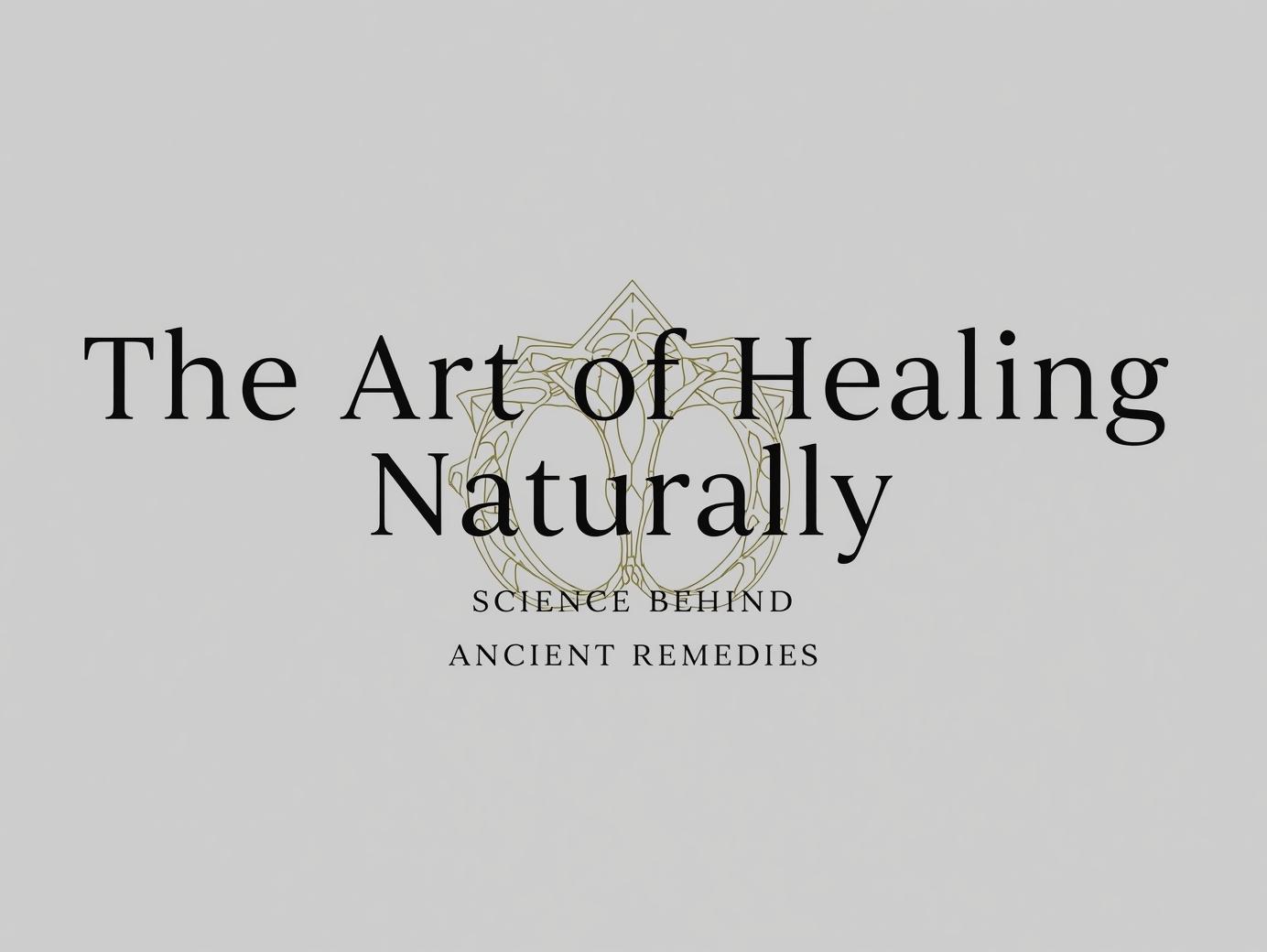Art of Healing Naturally
The Art of Healing Naturally
An Evidence-Based Exploration of the Science Behind Ancient Remedies
For millennia, before the advent of modern pharmacology, humanity relied on a vast and intricate apothecary provided by nature. Ancient healing traditions—from Ayurveda in India and Traditional Chinese Medicine (TCM) to the herbal wisdom of indigenous peoples—developed sophisticated systems for maintaining health and treating illness.
In our modern era, these practices are often viewed with a mixture of romanticism and skepticism. Are they merely relics of a pre-scientific age, or do they hold profound wisdom that modern science is only now beginning to validate? The truth, as we are discovering, is that many of these ancient remedies are not based on magic, but on sophisticated biochemical and neurological mechanisms.This guide will take you on a journey through the lens of science, exploring how these time-honored practices physically and measurably impact our biology.
A Journey Through Wisdom & Science
- The Core Philosophy: A Holistic View
- Herbalism 1: Turmeric’s Fiery Power
- Herbalism 2: Ginger’s Soothing Warmth
- Herbalism 3: Ashwagandha, The Stress Shield
- Mind-Body 1: The Neuroscience of Meditation
- Mind-Body 2: The Physiology of Yoga
- Physical Therapy: The Point of Acupuncture
- The Bridge to Now: Integrative Medicine
- A Word of Caution: Navigating with Wisdom
- Frequently Asked Questions
The Core Philosophy: A Holistic Worldview
Before examining specific remedies, it’s crucial to understand the shared philosophy that underpins most ancient healing systems. Unlike the often reductionist approach of modern medicine, which targets specific symptoms or pathogens, ancient wisdom typically embraces a holistic model.
Holism: Body, Mind & Spirit
The individual is seen as an interconnected whole. A physical ailment is not separate from one’s mental or emotional state. Treatment aims to restore harmony across the entire system.
Balance: The Dynamic Equilibrium
Health is viewed as a state of dynamic balance (homeostasis). Whether it’s the Doshas in Ayurveda or Yin and Yang in TCM, illness is seen as a sign of imbalance that needs to be corrected, not just suppressed.
Prevention over Cure
The ultimate goal is not just to treat sickness but to cultivate a lifestyle, diet, and mindset that prevent illness from taking root in the first place. The focus is on building resilience.
Turmeric (Curcuma longa)
Ancient Wisdom
Revered for over 4,000 years in Ayurvedic and Chinese medicine, the brilliant yellow spice known as “the golden goddess” has been a cornerstone remedy. It was traditionally used to:
- Reduce inflammation from injuries and arthritis.
- Support digestion and liver function.
- Purify the blood and enhance skin health.
- Serve as a potent antiseptic for cuts and wounds.
Modern Science
Thousands of studies have validated turmeric’s power, attributing it to its primary active compound, Curcumin. Modern science shows curcumin:
- Is a powerful anti-inflammatory that works by blocking NF-κB, a key molecule that activates genes related to inflammation.
- Acts as a potent antioxidant, neutralizing free radicals and boosting the body’s own antioxidant enzymes.
- Increases levels of Brain-Derived Neurotrophic Factor (BDNF), a growth hormone that functions in your brain, potentially delaying or even reversing brain diseases and age-related decline.
Ginger (Zingiber officinale)
Ancient Wisdom
A staple in kitchens and medicine cabinets from Asia to the Middle East, ginger was prized for its warming, stimulating properties. It was traditionally used to:
- Settle upset stomachs, nausea, and motion sickness.
- Relieve cold and flu symptoms by promoting warmth.
- Ease menstrual pain and muscle soreness.
- Stimulate circulation and “digestive fire” (Agni).
Modern Science
The main bioactive compound in ginger is Gingerol, which is responsible for much of its medicinal power. Research demonstrates that gingerol:
- Is highly effective against nausea, with studies showing its efficacy in treating morning sickness, chemotherapy-induced nausea, and post-operative nausea.
- Possesses strong anti-inflammatory and antioxidant effects, helping to reduce pain and inflammation in conditions like osteoarthritis.
- May help lower blood sugars and improve heart disease risk factors by improving cholesterol levels.
Ashwagandha (Withania somnifera)
Ancient Wisdom
A cornerstone of Ayurveda, Ashwagandha is one of the most important Rasayana (rejuvenating) herbs. Its name translates to “smell of the horse,” alluding to its ability to impart the vigor and strength of a stallion. It was used to:
- Reduce stress and calm the mind.
- Boost energy, strength, and vitality.
- Improve sleep and combat fatigue.
- Enhance memory and cognitive function.
Modern Science
Ashwagandha is now classified as an “adaptogen”—a substance that helps the body resist and adapt to physical and mental stress. Scientific studies show it:
- Significantly reduces levels of the stress hormone cortisol. High cortisol is linked to anxiety, weight gain, and chronic stress.
- Can reduce symptoms in people with stress and anxiety disorders, as shown in multiple human-controlled trials.
- Enhances brain function, including memory and reaction times, by protecting nerve cells from oxidative stress.
Meditation & Mindfulness
Ancient Wisdom
Practiced for thousands of years in traditions like Buddhism and Vedanta, meditation was a tool for spiritual enlightenment, mental clarity, and achieving inner peace. It was seen as a way to:
- Quiet the “monkey mind” of ceaseless thoughts.
- Cultivate compassion and reduce suffering.
- Develop focus and concentration.
- Gain insight into the true nature of reality.
Modern Science
Neuroscience has provided breathtaking insights into how meditation physically changes the brain (neuroplasticity). Brain imaging studies reveal that regular practice:
- Reduces gray matter density in the Amygdala, the brain’s “fight or flight” fear center, leading to lower stress reactivity.
- Increases gray matter thickness in the Prefrontal Cortex, the area associated with awareness, concentration, and decision-making.
- Quiets the Default Mode Network (DMN), the part of the brain responsible for mind-wandering and self-referential thought (“me-centered” thinking), which is often overactive in depression.
Yoga
Ancient Wisdom
Far more than just physical postures (asanas), traditional yoga is a holistic discipline designed to unite mind, body, and spirit. Its goals were to:
- Prepare the body for long periods of meditation.
- Regulate the flow of Prana (life force energy) through breathwork (Pranayama).
- Increase physical flexibility and strength.
- Purify the nervous system and calm the mind.
Modern Science
Modern physiology has validated many of yoga’s benefits, showing that it is a powerful tool for regulating the nervous system. Research indicates that yoga:
- Increases levels of the neurotransmitter GABA. Low GABA levels are associated with anxiety and mood disorders.
- Reduces heart rate, lowers blood pressure, and improves heart rate variability (HRV), all markers of a healthier stress response and a more dominant parasympathetic (“rest and digest”) nervous system.
- Improves proprioception (the sense of where your body is in space) and interoception (the sense of your body’s internal state), enhancing the mind-body connection.
Acupuncture
Ancient Wisdom
A key component of Traditional Chinese Medicine (TCM), acupuncture involves inserting fine needles into specific points on the body. It was based on the concept of Qi (vital energy) flowing through pathways called meridians. The goal was to:
- Unblock and balance the flow of Qi to alleviate pain.
- Restore balance between Yin and Yang in the body.
- Treat a vast range of conditions from headaches to infertility.
Modern Science
While the concepts of Qi and meridians are not part of the Western scientific model, research has uncovered several plausible physiological mechanisms for acupuncture’s effects, particularly in pain relief:
- Endorphin Release: Studies show that acupuncture stimulates the nervous system to release endorphins, the body’s natural painkillers.
- Gate Control Theory of Pain: The needle stimulation may activate nerve fibers that send signals to the brain, “closing the gate” on slower-traveling pain signals from the source of injury.
- Increased Blood Flow: The needles can trigger a local response that increases circulation to the area, which can help reduce inflammation and promote healing.
The Bridge to Now: Integrative Medicine
The most exciting development is the shift away from an “either/or” mentality toward an integrative approach. Integrative medicine thoughtfully combines the best of modern, evidence-based medicine with proven, safe, and effective ancient remedies.
(e.g., Anti-inflammatory diet, stress reduction via meditation)
(e.g., Targeted medications, advanced diagnostics)
A holistic, patient-centered approach that treats the whole person to achieve optimal health.
A Word of Caution: Navigating with Wisdom
While the science is promising, it is crucial to approach natural remedies with caution and respect. “Natural” does not always mean “safe.”
Lack of Regulation
Herbal supplements are often not regulated with the same rigor as pharmaceutical drugs. Quality, purity, and dosage can vary wildly between brands.
Potential for Interaction
Many herbs can interact dangerously with prescription medications (e.g., St. John’s Wort with antidepressants, turmeric with blood thinners).
Always Consult a Professional
Before starting any new supplement or alternative therapy, it is essential to speak with your doctor and a qualified practitioner (like a licensed acupuncturist or clinical herbalist).
Do Not Replace Proven Treatment
Ancient remedies should be seen as complementary to, not a replacement for, conventional medical treatment for serious health conditions.
Frequently Asked Questions
Look for third-party certifications on the label. Organizations like USP (U.S. Pharmacopeia), NSF International, and ConsumerLab.com test supplements for purity, potency, and contaminants. Choosing brands that voluntarily undergo this testing provides a higher level of assurance.
They are closely related. Mindfulness is the broader quality of paying attention to the present moment without judgment. Meditation is the formal practice you do to cultivate that quality. Think of mindfulness as being “fit,” and meditation as the “exercise” you do to get fit.
It’s more accurate to say they can help the body heal itself and manage chronic conditions. For acute, life-threatening illnesses, modern medicine is irreplaceable. But for chronic inflammatory, stress-related, and lifestyle-driven conditions, these ancient practices can be profoundly effective at restoring balance and function, often addressing the root cause in a way that medication alone cannot.
Discover more from Medical Hippie
Subscribe to get the latest posts sent to your email.

